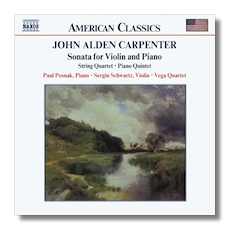
The Internet's Premier Classical Music Source
Related Links
- Carpenter Reviews
- Latest Reviews
- More Reviews
-
By Composer
-
Collections
DVD & Blu-ray
Books
Concert Reviews
Articles/Interviews
Software
Audio
Search Amazon
Recommended Links
Site News
 CD Review
CD Review
John Alden Carpenter

Chamber Music
- Sonata for Violin & Piano (1912)
- Quartet for Strings (1927)
- Quintet for Piano & Strings (1937)
Paul Posnak, piano
Sergiu Schwartz, violin
Vega Quartet
Naxos 8.559103 74:35
Summary for the Busy Executive: A Harvard gentleman from Chicago.
Like Charles Ives, John Alden Carpenter came from old New England stock (he claimed descent from the John Alden) and worked as a high-level business executive for his day job. At that point, all resemblance ends.
Carpenter was a hot ticket during the Teens and Twenties, writing out of an Impressionist idiom. Some of his solo piano music, while not exactly groundbreaking (remember that the Rite of Spring appeared in 1913), is extremely well-made, in ways similar to and at the same level of artistic ambition as Debussy's première Arabesque. His pieces Sea Drift and Adventures in a Perambulator typify this style. During the late Teens, he became interested in jazz, which kicked his music out of its genteel rut. Indeed, his most lasting works come from this period: Skyscrapers, Krazy Kat, and the piano concertino. During the Twenties, however, as American composers began to grapple with "hard" Modernism, Carpenter's stock fell. The music, often poetic and always beautifully shaped, simply hadn't the interest or the reach of something like Copland's piano concerto, Varèse's Ionization, or Antheil's Ballet Mécanique. Compared to our Neoclassics – Piston, Diamond, Schuman, Harris, and so on – it seemed stuck in an earlier era. I think it fair to say that Carpenter's music lacked an exploratory drive, such as one hears in the music of Griffes. He contented himself to rest on comfortable ground. I listen to a Carpenter piece and immediately think of a painting by Maurice Prendergast or Edmund Tarbell, rather than one by George Bellows or Lyonel Feininger.
The liner notes compare the violin sonata to Delius. While I don't normally seek out Delius' music, I can't let him be libeled, since he has at least a strong artistic personality and Carpenter's piece exemplifies one of my musical bêtes noires – the Nice Piece. It's not a sonata, so much as a series of Artistic Poses and Moods. The thematic material you forget almost as soon as you hear it, and there's really no argument to hold you. Instead, the composer strikes a series of attitudes, represented by the finale. A dinky theme, at the level of an Edwardian piano potboiler (perhaps "Harlequinade"), gets stated and mostly dropped, as the mood becomes more and more pretentious – that is, serious for no good reason. For me, this sonata just about defines musical kitsch.
The string quartet improves upon the earlier piece in every way. For one thing, each of the three movements actually make coherent statements, as opposed to resort to empty, second- and third-hand rhetorical gestures. Typical of Carpenter's music at the time, we get a tentative exploration of Modernism. The most aggressive of Carpenter's ideas tend to take on what Jelly Roll Morton called "the Spanish tinge," as if that kind of exoticism freed the composer from his conventional morning-jacket of musical mannerisms. My favorite movement is the second, a rapt meditation disciplined by a fairly tight rein on motific development. It represents Carpenter's music (and Impressionism in general) at its best: an intensity that seems to suspend the flow of time.
Carpenter's piano quintet appeared in the Thirties and sounds like he could have written it thirty or forty years before. Nevertheless, it shows the composer at his best. The first movement plays very subtle rhythmic games with an idea that sounds like an homage to the Baroque. Stravinsky and his disciples, of course, were at the height of their influence, but they don't really touch Carpenter here, who reverts to a late nineteenth-century idiom. The instrumental writing is both free and assured, as if the composer has felt no practical limits at all upon his thought. The voices speak their "own mind" with one another, and yet retain the social aspects of genuine conversation. The slow movement unfolds along a passionate, elegant arc, but with great economy of means. Again, the idiom lies closer to Schumann and Reger than to Debussy, although Carpenter can't resist closing on a whole-tone chord. Still, the meaning of that chord differs from the same sort of thing in Debussy. It's more of a relaxation of nineteenth-century chromaticism. The third movement comes as a big surprise. It not only raises the emotional level of the entire piece, but does so in something much closer to contemporary Modernism. It's muscular, "big-shoulder" music, what I imagine as Carpenter finally speaking in his genuine voice, rather than in some knock-off of John Knowles Paine (his teacher) or Dukas. Nevertheless, it works, and Carpenter finishes off with a particularly satisfying musical climax (although a recall of the primary theme of the first movement I can take or leave).
Schwartz (no relation) and Posnak, despite their considerable efforts, can't do much with the violin sonata. A sow's purse is a sow's purse, after all. However, they give it a pretty good shot. The Vega Quartet lovingly shapes the string quartet and adds to Posnak's muscle in the piano quintet. Carpenter will probably never be anyone's idea of a major composer, but he does have something worth saying and he entertains well. Thanks to Naxos for allowing us to explore at cheap rates.
Copyright © 2007, Steve Schwartz




















